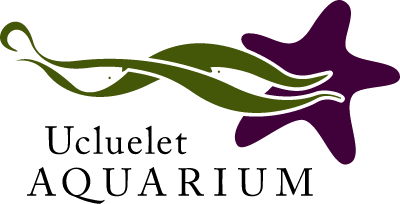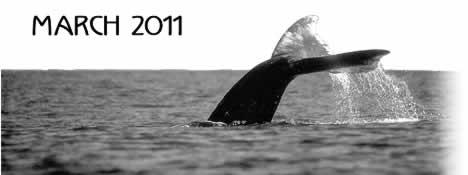
Drifters, Travellers & Commuters at Sea: What keeps Gray Whales going?
by David Hurwitz, Ucluelet Aquarium
 Bound for the polar seas they travel en masse on the longest migration of any mammal on the planet – what keeps the Gray Whales going?
Bound for the polar seas they travel en masse on the longest migration of any mammal on the planet – what keeps the Gray Whales going?
By the time they start their journey northward from their wintering grounds around Baja, they have lost twenty to thirty percent of their body mass. Their svelte silhouettes bear little resemblance to the plump creatures that headed south the previous autumn and by the time they reach the Arctic Ocean again they have gone without food for close to six months. It is over the summer that the Grays gorge on small invertebrates by the ton, bulking up enough reserves to carry them through another warm but snack-free winter. The thousands of Gray whales passing by our coast are following the call of an organ – their stomach!
Grays strain the water and soft mud through their baleen, dining on a variety of planktonic animals. It always amazes me that some of the largest animals on the planet are sustained by some of the tiniest life forms. What is plankton?
Plankton by definition consists of (chiefly) microscopic organisms drifting or floating throughout the water column. Phytoplankton is the smallest of single-celled plants that survive in the uppermost layers of the sea, the layer penetrated by sunlight. A single litre of sea water from this layer, called the photic zone, can contain 10-20 million of these simple plants. It is the accumulation of photosynthetic activity near the surface of the planet’s oceans that helps keep the air we breathe refreshed. Even if you don’t like seafood or surfing we all share a good reason to keep our oceans clean!
Zooplankton consists of small animals and the immature stages of some larger animals that drift in the water column. Amphipods and krill, two species of planktonic crustaceans, are the main diet of Gray Whales. Beach walkers will recognize amphipods as those jumping sand fleas that live around washed-up seaweed. Euphausids, also known as krill, are shrimp-like creatures that measure about a centimetre or two long. They are eaten by a myriad of marine species, and are one of the staples of aquarium diets. A school of translucent krill can occasionally be spied in shallow water; keep a look out for a cloud-shaped shadow that moves around with the tide line.
Some species defined as planktonic may have the capability for locomotion but are still unable to swim independent of the ocean’s currents. Jellyfish are a great example of this type of plankton but many are far from microscopic. There are some jellyfish that have tentacles almost 30 metres long and one particular species off our coast that is reputed to stretch out to 135 meters or 446 feet long! That’s a planktonic organism about four times as long as the largest Blue Whale ever recorded!
Many larger animals start off in a planktonic phase and travel on the tides until they ‘settle out’ as larger mobile specimens. While adult Dungeness crabs are not considered plankton, their tiny hatchlings called zoea larvae are. Over a million zoea larvae hatch from a female crab; many are destined to become another animal’s meal. These larval crabs can boogie on the currents and a Dungeness crab from BC could have origins in California or Alaska. Some drifters get around!
Some plankton floats on the water and is carried by ocean breezes and surface currents. These organisms are called neuston. Velella velella, the by-the-wind-sailor is a beautiful blue jelly with an alliterative name and a sail that propels it to its fate.
But some sea creatures are self-propelled, the opposite of plankton, like salmon, octopus, and… Gray Whales. They out-swim their prey and can migrate great distances to find food or mates. Scientists refer to marine animals that are able to swim independent of the ocean’s currents, as nekton. Nekton includes some of the fastest swimmers and many of the top predators in the sea. Much of the seafood we enjoy is nekton. And some large marine animals that are nekton, like our Gray Whales, survive on over a ton of plankton a day. Plankton forms the base of many food webs and is responsible for much of life on Earth.
If you’re still trying to decide whether you’re plankton or nekton, come talk to us at the Ucluelet Aquarium on the Main Street Promenade in Ucluelet, open daily from March 19th through October for 2011.

Dave Hurwitz is the curator/executive director of the Ucluelet Aquarium Society.
Tofino Whale watching articles
- A Foggy Adventure May 2002
- A Whale‘s Tale March 2003
- Get Ready for Whale Festival! February 2011
- Grey Whales in our Back Yard March 2011
- What keeps Gray Whales going? March 2011
- Ocean Day: June 8th June 2002
- Orcas in Clayoquot December 2002
- Strawberry Island 2002 March 2003
- Strawberry Island Scuttlebutt May 02 May 2002
- Strawberry Island Scuttlebutt Aug.02 Aug. 2002
- Strawberry Island Scuttlebutt Dec.02 Dec. 2002
Tofino Time March 2011
- Tofino Time Readers’ Choice Awards 2011:
The Best of Tofino 2010 - Tofino Surf: Pumping on a Frontside Wave
- Tofino tides: Tide table for Tofino March 2011
- Tofino surf reports for March 2011
- Tofino concerts in March 2011
- Movies in Tofino: March 2011
- Tofino events in March 2011
- Grey Whales in our Back Yard
- Commuters at Sea: What keeps Gray Whales going?
- Wildlife photographer Matthew Maran
- Pacific Rim Whale Festival: March 19-27, 2011
- Artsplash! Pacific Rim Arts Society Spring Art Festival 2011
- Whale Festival poster artist: Mark Hobson
- Food from the Ocean: Weeds of the Sea
- Tofino gardening tips for March 2011
- Tofino yoga classes in March
- Horoscope for March 2011
- West Coast Winter Music Series 2010/11
- Community Directory: Goods & Services in Tofino
tofino | tofino time | activities | accommodation | events | directory
maps | travel | food | art & artists | photos | horoscope | tides
search | magazine | issues | articles | advertising | contact us
hosted in tofino by tofino.net & studio tofino
© 2002-2014 copyright Tofino Time Magazine in Tofino Canada
What keeps Gray Whales going on their annual migration that brings them past the waters of Tofino? Plankton - microscopic organisms drifting through the water.

quick links:
- tofino accomodations
- tofino calendar
- tofino surf report
- tofino horoscope
- march horoscope
- tofino map
- tofino fishing report
- tofino tides
- tofino weddings
tofino events:
- tofino concerts
- tofino events
- tofino movies
- tofino festivals
- tofino yoga classes
- tofino whale festival
tofino time magazine:
- tofino time march 2016
- tofino event listings march 2016
- tofino concerts in march 2016
- tofino movies in march 2016
- cox bay | wickaninnish beach
- chesterman beach
- tonquin beach
- tofino brewing co.
- tofino wedding guide
tofino accommodation:
- tofino cabin
- tofino camping
- bed & breakfasts in Tofino
- tofino hostels
- tofino motels
- tofino hotels
- tofino vacation rentals
- petfriendly accommodation
activities:
- tofino bike rentals
- tofino bear watching
- tofino bird watching
- tofino boat charters & cruises
- tofino fishing
- hot springs cove
- sea kayaking in tofino
- tofino storm watching
- tofino surfing
- tofino whale watching
- tofino yoga
shopping:
services:
- tofino yoga, spa & wellness
- tofino restaurants
- tofino internet cafes
- tofino travel & transportation
- tofino real estate
- tofino taxi services
- tofino wedding & events
